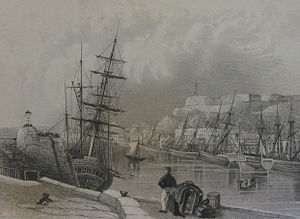Fort Regent
| Fort Regent | |
|---|---|
| Saint Helier, Jersey | |

Fort Regent in 2008.
|
|

Fort Regent in the 19th century.
|
|
| Coordinates | 49°10′53″N 2°06′21″W / 49.1813°N 2.1059°W |
| Type | Fortification |
| Site information | |
| Owner | People of Jersey |
| Controlled by | States of Jersey |
| Open to the public |
Yes |
| Condition | Intact |
| Site history | |
| Built | 1806 to 1814 |
| Materials |
Granite Carboniferous limestone |
| Garrison information | |
| Garrison |
British Army Jersey Militia Wehrmacht (1940 - 1945) |
Fort Regent is a 19th-century fortification, and leisure centre, on Mont de la Ville (Town Hill), in St. Helier, Jersey. The fort is in close proximity to the fortified South Hill, Engineers Barracks at La Collette, and overlooks the 16th-century Elizabeth Castle and harbour to the west.
The fort's main features are substantial curtain walls, ditches, a glacis, redoubts, bastions, and redans (or demi-bastions). A parade ground was in the centre, which is now built upon, and covered with a roof.
A dolmen was located on the hill, prior to the construction of Fort Regent. In 1785, workmen, who were leveling the area for use as a parade ground, uncovered the dolmen. The dolmen was gifted to Henry Seymour Conway, who removed it to his home, Park Place, near Henley-on-Thames, in 1788.
During the Middle Ages the Town Hill, and near-by Petit Mont de la Ville were used as common land. The Chapel of Notre Dame des Pas was situated at the foot of the hill during this period, but was demolished by the Board of Ordnance in 1814.
In 1550, Edward VI ordered the town to be relocated onto the hill, because it would be easier to defend in that position. However, the town was never moved.
In 1591, an intention to fortify the hill arose in the form of consent, from the Procureurs of the Vingtaine, to acquire the common land from the people, with their consent, so that fortifications can be constructed. The document referred to letters from Elizabeth I promising to fortify the top of the hill to provide defence for the town. Despite this, no evidence exists of any work being carried out during the 16th century.
...
Wikipedia

